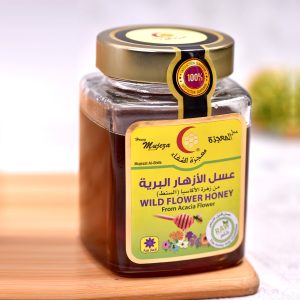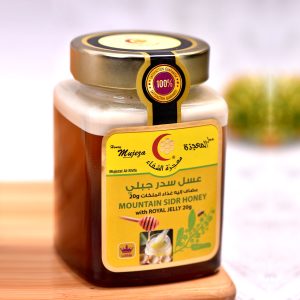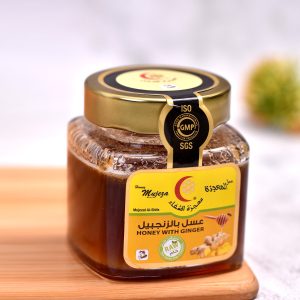MOUNTAIN SIDER HONEY 3 kg
In stock
KWD25.000 KWD33.000
In stock
Definition
Luxury natural honey extracted by bees from the jujube nectar (jujube plant) derived from the Acanthoid subfamily that grows in arid mountains in the Arabian Peninsula and the surrounding areas.
Benefits
- Strengthening the nervous system, beneficial for Insomnia and migraines.
- Stop formation of gases in Irritable Bowel Syndrome.
- Heal ulcers of duodenum and stomach and neutralize excess acidity.
- Relive asthma, allergy and arthritis.
- Used on surface wounds and burns
- Very Nutritious for anemia and strength of the heart, for liver and prostate diseases.
- Useful for pregnant women and Nutritious for her fetus.
- It can be dripped in for eye diseases after being diluted in distilled water.

PURE MOUNTAIN SIDR HONEY (SADER) – JUJUBE HONEY
Definition
Luxury natural honey extracted by bees from the jujube nectar (jujube plant) derived from the Acanthoid subfamily that grows in arid mountains in the Arabian Peninsula and the surrounding areas.
The Sidr tree, (Scientific Namealso : Lotus Jujube, Buckthorn) is one ancient types of tree. The Jujube fruit was the first food Prophet Adam (pbuh) ate when he was made to descend to earth. The tree was used during the time of King Suleiman (pbuh) and the Pharaohs to build palaces and temples. This highly resilient tree is also sacred as it is mentioned four times in the Qur’an. In Sura Saba, it is mentioned as an earth tree while in other Suras, it is mentioned as a tree close to Al Mawaa Heaven (Sidrat al-Muntaha). Allah has mentioned this tree to emphasize its beauty, strength and grandeur (Saba 15,16; Waqeaa 27-33; Najm 7-18). It is a sturdy and deep-rooted tree which has withstood the devastating floods of Eram in Yemen with two other trees: the Tamarisk and the Mustard Tree. (Saba 15,16).

Sider Honey:
This honey is known by its high nutritional characteristics and it is requested by the citizens of these regions because of its multiple particularities and they used to offer it in the ancient time as gifts for kings and leaders as a sign of love and respect. Sidr honey enriched with vitamins, minerals, amino acids methylglyoxal (MGO) content when compared to all other types of honey available in the world market when it comes to quality also sidr honey has lowest water content which does not only increases its potency of immune system boost up but also increase its shelf life.
Benefits
· Strengthening the nervous system, beneficial for Insomnia and migraines.
· Stop formation of gases in Irritable Bowel Syndrome.
· Heal ulcers of duodenum and stomach and neutralize excess acidity.
· Relive asthma, allergy and arthritis.
· Used on surface wounds and burns
· Very Nutritious for anemia and strength of the heart.
· Useful for pregnant women and Nutritious for her fetus.
· It can be dripped in for eye diseases after being diluted in distilled water.
MODE OF USE
Take one tablespoon of honey dissolved in a half glass of lukewarm water. This helps your body absorb all its beneficial properties. Pediatric dose is a half tablespoon. It could be repeated three times daily, one hour before meals. And to keep you healthy, Mujeza Honey can be consumed as desired.
Notification:
Not eaten by children under one year of age also allergic people for honey and bees products
NEW FROM MUJEZA HONEY – NATURAL RAW HONEY
From the hive to the bottle
Unheated- Unprocessed – Unfiltered
Informations about Sidr Honey
Sidr honey is produced by bees who only feed on the nectar of Sidr trees, one of the oldest trees that mentioned in the Holy Quran. Sider honey is considered one of the finest honey and it’s been known for healing benefits since ancient time. The herbalists preferred it for curing diseases and promoting health because it gives better results comparing with other types of honey. Sidr honey has many variants; each has different features and specifications, all of which captured the attention of researchers in the Kingdom of Saudi Arabia who have conducted several experiments on samples of honey from all over the world (available in Saudi market). They found that Sidr honey contains a high proportion of metals.
Sidr honey is characterized by golden light color; it darkens and tends to redness over time. While fresh and newly produced, it reminds you the same aromatic smell of Sidr tree in the month of October, the season when Sidr tree is flowering. Sidr honey is different from one region to another, so the variations in taste, color, aroma and density. All variants share the exquisite taste, splendid aroma and all of them are very expensive.
In Saudi Arabia, Sidr trees are found in areas close to Yemen, where the Kingdom of Saba used to be “the home of Sidr which is mentioned in the Holy Quran verse 16 of Sura Saba, “and something of few Sidr”. Each valley of Yemen has story to tell about Sidr.
Among the most famous areas in Yemen for producing Sidr honey are Dowan in Hadramout, jardan, Bayhan in Shabwa. In all these areas honey bees feed themselves exclusively on the nectar from the Sidr trees. Like other types of honey, Sidr honey needs good care through all stages starting from production to packaging, testing of samples and storage. Honey is very sensitive and it change at the lowest degree of temperature, any mistake while processing might turns it into harmful material instead of being healthy.
Some researches took place in Egypt had shown higher percentage of antioxidants in Sidr honey compared with other types of honey. Sidr trees in Egypt are found in Sina and other areas. When our General Manager visited the Valley of Tur Mountain in Sina, he received Sidr honey as a gift from beekeepers there.
According to tests carried out by the laboratory technician Zabihullah Ahmed Reda at (Mujeza Al-Shefaa in Kuwait – quality control department) Sidr honey doesn’t change when exposed to heat, whether low, medium or high and even at the temperature of 80° C degree, except that little thing, which is negligible in terms of both sugars diverse it contains or enzymes that rate of its change in other types of honey is very fast even when exposed to low temperatures, Also the rise of HMF (an indicator of the adulteration of honey with invert syrups -syrups of glucose and fructose), did not rise in Sidr honey except for two degrees or three degrees, while it rose in the other types of honey and reached up to 30 and even 50 degrees (in ppm) at temperature of 70-80 ° C within half an hour.
Also a sample of old Sidr honey stored in sealed glass for 10 years is examined in the same laboratory, it shows no changes in the chemical composition, quality specifications and the percentage of HMF didn’t increase.
When the director of the company and founder asked the Director and Technician of the laboratory of quality in Kuwait about his experiences and observations over the past years about the types of honey entering the country, he told us that he found this type (means Sidr honey) is the finest honey and completely comply with the required standards and specifications. Several laboratory examinations were done on Sidr honey at Kuwait Institute for Scientific Research (a governmental research foundation with high potential and high-tech devices) it has confirmed the quality of Sidr honey.
In a recent study by researcher Dr. Aman Ahmed Mohammed Zubair from the University of “UCSI” in Kuala Lumpur, Malaysia supervised by Dr. Patrick Oukichacoa, demonstrated the effectiveness of Sidr honey in treating inflammation, reducing hectic fever, stabilize activity of the body’s cells, protect against infections and relieve pain. The study, conducted on (rats) showed that, the pharmacological effect of Sidr honey is higher than aspirin and indomethacin (an anti inflammatory and pain relievers).
Researches are still underway to determine the pharmacological mechanisms of Sidr honey and its effectiveness for treating other diseases, the study is the first scientific document published internationally. The study was published in the magazine (World Academy of Medical Sciences, Engineering and Technology) and high court. Also the research was discussed in a conference held in France – Paris Augustus 2011, and Britain – London Dec, 2011. It worth mentioning that the investigator was a girl student from Yemen studying Medical genetics and biotechnology in Malaysia. She’s a member of the American Society for Pharmacology and therapeutics, and a member of the British pharmaceuticals society.
Despite these obvious facts, Sidr trees is still surrounded with a lot of ambiguity in the Arab culture, it says that Sidr honey is been used in magic and sorcery along with others treatment uses. Hundreds years ago, Sidr honey was given as a gift to kings, princes to express appreciation and loyalty. In other cultures, we found that old Indian used Sidr honey to solve eyes’ problems and clear vision. In Western culture, Sidr trees is sacred among Christians.
The Arab Beekeepers Union, during its sixth international conference, revealed a research conducted at the Faculty of Medicine – University of Aden with the aim of studying the effect of four types of Yemeni honey: Sidr, Sumor, Qasas, and Almarai for the treatment of abscesses in the breast and buttocks.
The results indicated that there were vital statistical differences (0.01) between the effect of the types of honey used in the dressing period until full recovery. The period was shorter when using Sidr honey, where the average treatment period was 8 days, followed by Sumor honey, and the average treatment period was 9.75 days. While the treatment period with Qasas honey was 10.5 days. As for the treatment period with Almarai honey, it was the longest, as it was 13.25 days. The results showed that there were no significant statistical differences in the treatment period when using the types of honey: Sidr, Sumor, and Al-Qasas in treating breast abscesses. The period of dressing until full recovery was 11.00, 8.33, 8.33 days, respectively.
The Union of Arab Beekeepers also revealed, during its sixth international conference, another research conducted by the Plant Protection Department at the Faculty of Agriculture – Sana’a University, with the aim of knowing the effect of six types of Yemeni honey, namely, Salm, Sidr Wasabi, Sidr Doani, Flowers, Pasture Do’ani, Sumor and another Australian commercial with five Concentrations (.5%, 1%, 5%, 10%, 20%) against the bacterial growth of Salmonella, Escherichia coli, Staphylococcus aureus, Pseudomonas, aurogenosa, Proteus, and the results indicated that Salam, Flowers, and Pasture Honey were the best. Influence on the tested bacteria, Sidr Wasaby honey comes in second place in terms of the selected antibacterial effect. While Sidr Doani honey and Alsalm honey came in third place. Commercial honey was shown to encourage bacterial growth. The results showed that the best concentrations affecting the growth of the tested bacteria for collecting honey species were 20%, followed by 10%. Marai Doaani honey was distinguished by its anti-growth ability of bacteria aurogenosa, E.coli, Pseudomonas at all concentrations, and showed low anti-growth of Staphylococcus aureus at concentrations 5%, 10%, 20%. Sidr Doaani honey is superior to all types of honey in its anti-bacterial effect, with high vitality at 20% concentration. Low concentrations of 0.5%, 1%, and 5% of most honeys were shown to encourage growth of the tested bacteria similar to or higher than the control.
Key words: honey, antibacterial, pathogenic bacteria and Yemen.
New From Mujeza Honey – Natural Raw Honey
From The Hive To The Bottle
Unheated- Unprocessed – Unfiltered


The best ways to check honey at home
There are several ways to know if honey is natural, beneficial, or unnatural (because it may be natural but not beneficial if it is treated in unhealthy ways such as heating):
The first method: Look carefully at honey because natural honey contains impurities, whether on the surface or inside the honey package, while the unnatural is very transparent like glass so that it does not obscure the vision from behind the package.
The second method: by smelling honey, honey has a smell that may be pungent or weak, which is the smell of flowers and fields from which honey was produced by bees, while honey that is not natural or useful has no smell.
The third method: Taste honey, natural honey has a flavor, which is the flavor of flowers and plants, while unnatural honey is just sweetness, meaning sweet like sugar syrup without any special taste
Fourth method: Eat honey, if it was natural, then it relaxes your stomach and you do not feel any discomfort in the stomach, but if the honey is not natural, you will feel a burning sensation in the stomach that does not fade away except by drinking water several times throughout the day.
LABORATORY EXPERIMENTS IN MICROBIOLOGY DEPARTMENT
Mujeza Laboratory tests the effectiveness of sider , Manuka, and black cumin honey in killing microbes
Laboratory experiments in the microbiology department
Experiments begin through the Mujeza laboratory by creating a culture of germs, microbes and yeasts and observing the ability of some types of honeys (Manoc honey – Sidr honey – Black seed honey) to eliminate them.
Determining the types of honey according to the botanical (syphilis) and geographical source:
Each type is distinguished by its special physical characteristics that beekeepers and honey tasters know only, such as the color of honey, its taste, its flavor – and its smell that is transmitted to the honey from the flower. Exposed to high heating loses the aroma and flavor of honey)
– Each type is characterized by a special color from transparent to white, yellow, red, brown, dark and black, and this is according to the flower and beekeepers distinguish it easily and to measure the color of honey there is a special device called pfund measurement
– According to the electrical connection number of each type of honey, it is identified by a special device in the laboratory.
– The most important method that is universally relied upon to determine the flower of honey and the geographical location of honey is to determine the type, shape and number of pollen grains in honey by microscope and matching it with pollen grains around the world through the pollen atlas. They are like the fingerprint of each honey precisely.
فحص حبوب اللقاح لعسل السدر الجبلي

pollen grain under microscope
a bee with pollen grains
General information about pollen:
Pollen grains stick to the legs of the bees when they frequent various types of flowers, thus moving with them to the honey from the flower. For example, the shape of the pollen grains of the Yemeni Sidr flower is different from the shape of the pollen grains of the Pakistani Sidr flower or others.
It is not possible to add pollen from another flower or another area to honey to change the source of honey because the shape and size of the pollen grain added to honey by the bees takes place after several changes, treatments and chemical additions carried out by the bees and thus completely different from the pollen added by humans.
Each drop of honey contains very high percentages of pollen grains, the least of which is (10,000) ten thousand pollen grains, and it may reach 100,000 pollen grains, and the higher the percentage, the better for human health.
The consumer can notice pollen grains in honey either on the surface of unfiltered honey or inside the honey package in the form of impurities and sediments.
Commercial companies clean and filter honey from pollen because the presence of pollen in honey helps to speed up the crystallization of honey (honey freezing) and to create a bright and attractive food product for the consumer, but this type of honey is considered of little benefit to human health.
American honey is completely free of pollen because the American law for the quality of honey considers pollen an extraneous element to honey and must be filtered.
European honey contains pollen because the European law for the quality of honey prevents the filtering of honey from pollen completely. You also find that honey for beekeepers contains very high amounts of pollen, and therefore honey crystallizes quickly in them, but it retains its health benefits for humans.
In each drop of honey there are hundreds of types of pollen, but honey is called the flower name based on the highest percentage of pollen, as if we call honey “clover honey” means that the percentage of clover pollen has the highest percentage among the pollen of the rest of the flowers.
LABORATORY TEST RESULT (ANALYSIS REPORT)
Analysis Report
General Information
| Company Name | Mujezat Al-Shifa | Date Received | 01/09/2021 |
| Product Name | Mountain Sidr Honey
(Jujube Honey) |
Date Report | 10/09/2021 |
| Weight | 500 | Methodology | HPLC(UV-IR ), UV Spectrophotometer |
| Pure sidr honey
|
Ingredient:
1-Physical Tests
| No | Parameters | Observation | CODEX STD 12-19811 | Remarks |
| 1 | Physical Properties | -Not have any foreign taste rather its natural sweetness.
-Honey chunks not contain bee’s eggs or larvae. -Not contain any artificial sweetener.
-Not be altered due to over heating or fermentation. – Free from impurities. -free from food additives. -Acidity not artificially change |
-Shall not have any other foreign taste rather its natural taste.
– Honey chunks not contain
-Shall not contain any artificial sweetener bee’s eggs or larvae. -Shall not be altered due to over heating or fermentation – Free from impurities. -free from food additives. -Acidity not artificially change |
Acceptable |
| 2 | Color Designation | Light Amber | O.D at 560nm= 0.421mAU | |
| 3 | PH-Value | 5.8 | Acceptable | |
| 4 | Electrical Conductivity | 0.76mScm-1 | Less than 0.8mScm-1 | Acceptable |
| 5 | Specific Rotation 1 | Polarized light to left | Polarized light to left | Acceptable |
- Chemical Tests
| Parameter | Observation | CODEX STD 12-19811 | Test Method
& Temperature |
Remarks | |
| Hydoxy Methyl Furfural
HMF |
1.3mg/kg | Not more than 80 mg/kg
AS GSO 147(2007) |
AOAC 980.23
R.T |
Acceptable | |
| Moisture(water)% | 17.0% | Not more than 20% | MAFF Validated
V21 RT |
Acceptable | |
| Fructose%
|
36.0% | – | HPLC R.I | – | |
| Glucose%
|
25.9% | – | HPLC R.I | – | |
| Sucrose%
|
2.9% | Not more than 5% | HPLC R.I | Acceptable | |
| Maltose%
|
2.4% | – | HPLC R.I | – | |
| Invert sugar% | more than 60% | More than 60% | HPLC R.I | Acceptable | |
| DN NO:
(DIASTASE NO) |
24.0 | Not less than 8 | AOAC 958.09 RT | Acceptable | |
| Water activity 1
Water activity 2 Water activity 3 Water activity 4 Water activity 5 |
0.086
0.085 0.096 0.089 0.082 |
Not more than 0.1g/100g | MAFF Validated
V22 R.T |
Acceptable
|
|
| Antibiotic- chloramphenicol,
tetracycline |
0.00
0.00 |
Should be absent | Randox test – ELISA | Acceptable
|
- MICROBIOLOGICAL TESTS
| No | INVESTIGATION | OBSERVATION | CODEX STD 12-19811 | REMARKS | TOTAL UNCERTAINITY FOR THE METHOD | METHOD USED
|
| 1 | Yeast and mold | 0 | Std-103 | Acceptable | 0.000422 | Campden 6.1:1994 |
Analyst -Mrs. Dhanuja chittil Approved by lab Manager: Mr. Yaser Megahed
,











